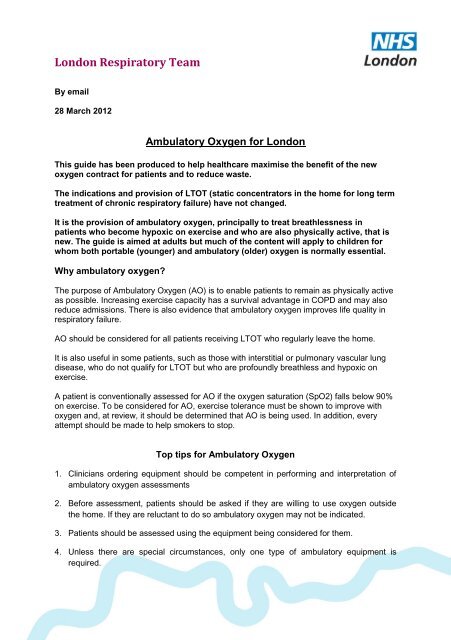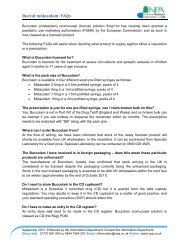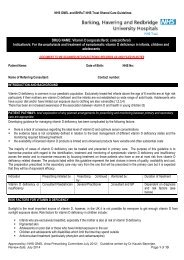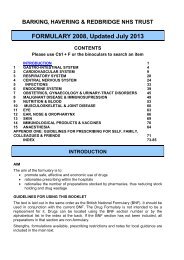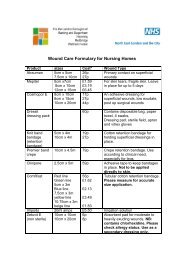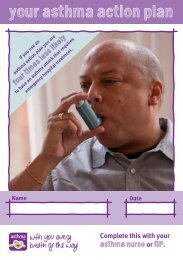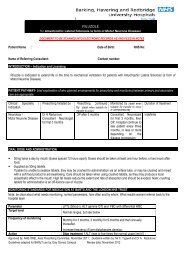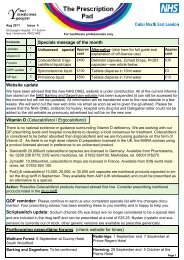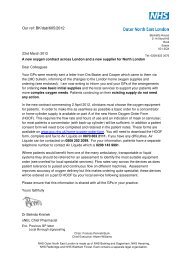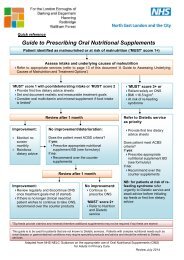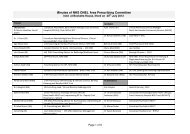Ambulatory oxygen for London letter - Barking and Dagenham ...
Ambulatory oxygen for London letter - Barking and Dagenham ...
Ambulatory oxygen for London letter - Barking and Dagenham ...
You also want an ePaper? Increase the reach of your titles
YUMPU automatically turns print PDFs into web optimized ePapers that Google loves.
<strong>London</strong> Respiratory TeamBy email28 March 2012<strong>Ambulatory</strong> Oxygen <strong>for</strong> <strong>London</strong>This guide has been produced to help healthcare maximise the benefit of the new<strong>oxygen</strong> contract <strong>for</strong> patients <strong>and</strong> to reduce waste.The indications <strong>and</strong> provision of LTOT (static concentrators in the home <strong>for</strong> long termtreatment of chronic respiratory failure) have not changed.It is the provision of ambulatory <strong>oxygen</strong>, principally to treat breathlessness inpatients who become hypoxic on exercise <strong>and</strong> who are also physically active, that isnew. The guide is aimed at adults but much of the content will apply to children <strong>for</strong>whom both portable (younger) <strong>and</strong> ambulatory (older) <strong>oxygen</strong> is normally essential.Why ambulatory <strong>oxygen</strong>?The purpose of <strong>Ambulatory</strong> Oxygen (AO) is to enable patients to remain as physically activeas possible. Increasing exercise capacity has a survival advantage in COPD <strong>and</strong> may alsoreduce admissions. There is also evidence that ambulatory <strong>oxygen</strong> improves life quality inrespiratory failure.AO should be considered <strong>for</strong> all patients receiving LTOT who regularly leave the home.It is also useful in some patients, such as those with interstitial or pulmonary vascular lungdisease, who do not qualify <strong>for</strong> LTOT but who are profoundly breathless <strong>and</strong> hypoxic onexercise.A patient is conventionally assessed <strong>for</strong> AO if the <strong>oxygen</strong> saturation (SpO2) falls below 90%on exercise. To be considered <strong>for</strong> AO, exercise tolerance must be shown to improve with<strong>oxygen</strong> <strong>and</strong>, at review, it should be determined that AO is being used. In addition, everyattempt should be made to help smokers to stop.Top tips <strong>for</strong> <strong>Ambulatory</strong> Oxygen1. Clinicians ordering equipment should be competent in per<strong>for</strong>ming <strong>and</strong> interpretation ofambulatory <strong>oxygen</strong> assessments2. Be<strong>for</strong>e assessment, patients should be asked if they are willing to use <strong>oxygen</strong> outsidethe home. If they are reluctant to do so ambulatory <strong>oxygen</strong> may not be indicated.3. Patients should be assessed using the equipment being considered <strong>for</strong> them.4. Unless there are special circumstances, only one type of ambulatory equipment isrequired.
5. After starting LTOT, an initial 2 month trial using portable cylinders may be useful be<strong>for</strong>eundertaking a full assessment. Use during this period may then guide equipmentselection.6. The Modality selection tool may help in ambulatory <strong>oxygen</strong> selection but does not takeinto account life-style or patient ability to use the equipment.7. Use st<strong>and</strong>ard 3 day delivery when ordering ambulatory <strong>oxygen</strong>.8. As with LTOT, ambulatory <strong>oxygen</strong> may not be appropriate if patients smoke.9. After considering barriers to use, consider removing ambulatory <strong>oxygen</strong> if not beingused.10. The <strong>oxygen</strong> equipment provided by the NHS should not be taken outside the UK. Thegas supply company may enable such trips to be made through a private arrangementwith patients.Patient selectionThree groups of patients, characterized by their different <strong>oxygen</strong> requirements, arerecognised (BTS clinical component of HOS, 2006):Group 1 : LTOT patients who only walk short distances outdoorsThis is the majority of advanced COPD patients on LTOT.They will have limited mobility but may still leave the house regularly.In most, a complex assessment is not required.A st<strong>and</strong>ard portable cylinder will usually be prescribed to enable trips away from home.A long lead from the O2 concentrator should suffice <strong>for</strong> most activities of daily living indoors(bearing in mind the danger of trips <strong>and</strong> falls).The ‘ambulatory’ flow rate will usually be set at the LTOT flow rate but may need increasing<strong>for</strong> more significant exertion, such as climbing stairs, or during an AECOPD.A HOOF B should be completed, ordering sufficient cylinders to meet the needs of thepatient <strong>and</strong> avoid frequent deliveries.Group 2 : More mobile LTOT users <strong>and</strong> those LTOT users with CF, ILD etc who take regularexerciseThese patients are often recognised as needing AO at PR programmes.They tend to be younger with less co-morbidity.They require specialist assessment to maximise the benefit of the new ambulatory devices<strong>and</strong> to explain the benefits <strong>and</strong> rationale of AO.1-2 visits will be required <strong>for</strong> equipment titration with a subsequent follow up at 3/12 toensure AO is being optimally used. Thereafter, follow up will normally be by the localarrangements <strong>for</strong> monitoring <strong>oxygen</strong>.
Group 3: Non LTOT patients who are limited by severe breathlessness relating to <strong>oxygen</strong>de-saturationThese patients will often have interstitial lung disease ILD), chest wall disease (scoliosis orprofound obesity) or pulmonary vascular disease.They will require specialist assessment.Why does the new contract make specialist assessment necessary?<strong>Ambulatory</strong> <strong>oxygen</strong> has been unpopular with clinicians <strong>and</strong> with many patients in the past.This was mostly because cylinders were heavy <strong>and</strong> insufficient flow rates were prescribed.As a result, the cylinders were used as a portable supply of <strong>oxygen</strong> rather than asambulatory devices.The new contract offers many new modalities that enable much greater benefit from AO. Inmany cases, however, they dem<strong>and</strong> individual patient assessment <strong>and</strong> review.The new equipment includes:St<strong>and</strong>ard <strong>and</strong> lightweight ambulatory cylinders +/- conserverSelf-fill cylinders (a compressor on top of a concentrator)Liquid <strong>oxygen</strong> (LOX) portable flask refillable from a home reservoir (Dewar)A portable concentrator (that can be carried or pulled on a trolley)A transportable, wheel along concentrator that can provide LTOT at home <strong>and</strong> ontrips away from home. It is not suitable <strong>for</strong> ambulatory use but has a battery option.Home-fill cylinders from O2 concentratorThe self-fill system consists of a concentrator <strong>and</strong> compressor that re-fills portablecylinders.Self fill has the advantage of independence from the need <strong>for</strong> regular deliveries but itdelivers a pulsed dose which may limit its value <strong>for</strong> some patients.When simultaneously using the concentrator to provide static <strong>oxygen</strong>, the fill time ofthe portable cylinder is prolonged.Patient/family should be capable of filling cylinders as social carers may not beallowed to do so.Transportable concentratorThe transportable concentrator is only suitable <strong>for</strong> patients requiring flow rates ofcontinuous <strong>oxygen</strong> up to 3 litres per minute.It is best used <strong>for</strong> providing static <strong>oxygen</strong> in patients who spend time away fromhome on a regular basis.In these circumstances, it should be used as the LTOT <strong>oxygen</strong> source <strong>and</strong> replacethe static concentrator.
Although it may not be required, a back-up cylinder is routinely provided with thetransportable concentrator.Portable concentratorsThe portable concentrator only delivers pulse <strong>oxygen</strong> <strong>and</strong> is more suitable <strong>for</strong>convenient <strong>oxygen</strong> delivery when travelling rather than ambulatory use.The 5 settings are not equivalent to flow rate (litres per minute) <strong>and</strong> will be lesseffective.The portable concentrator should be the main source of portable/ambulatory <strong>oxygen</strong>if prescribed.Liquid OxygenLiquid <strong>oxygen</strong> best suits patients who remain physically active or who are regularlyout of the home <strong>for</strong> several hours <strong>and</strong> require high flow rates.The patient or carer needs to be able fill the portable flask from the reservoir tank(Dewar). Homes above the second floor are likely to be unsuitable because ofdifficulties with delivery of the Dewar.Home <strong>oxygen</strong> prescribingThe provision of basic ambulatory equipment will be available from most acute sites thatregularly arrange home <strong>oxygen</strong> prior to discharge <strong>and</strong> from community services that assesspatients <strong>for</strong> HOS in the home or in a community facility.Staff will often carry out simple assessments to look <strong>for</strong> <strong>oxygen</strong> de-saturation on exercise.National recommendations are <strong>for</strong> such services to sit within a comprehensive <strong>and</strong>integrated COPD service.More specialist assessment will be carried out in a limited number of specialist centres. Staffwill be familiar with the wide range of equipment <strong>and</strong> be able carry out exercise tests usingthe different modalities to best meet the complex needs that some patients have. ThePrimary Care Commissioning Good Practice Guide (2011) provides further in<strong>for</strong>mation onHOS-ARS services.<strong>Ambulatory</strong> <strong>oxygen</strong> assessment centres will have:An area in which walking tests can be carried outStaff with experience <strong>and</strong> trainingA & C support : to maintain records, appointments etcSpirometry, oximetry <strong>and</strong> ABGs/ELBGs capabilityThe equipment available in a specialist centre is likely to include:O2 concentratorsSt<strong>and</strong>ard & light weight cylindersLOX & flasksConserver devices <strong>for</strong> O2 cylindersAspects of assessment:A reproducible exercise test should be used to assess the appropriate flowrate/setting of a device. Endurance tests may be more sensitive than maximalexercise tests (Davidson et al, 1988, Eaton et al, 2006).
The different ambulatory devices have advantages <strong>and</strong> disadvantages e.g. weight,flow profile, respiratory rate limits etc. Patients should be assessed on the devicethat is likely to best suit their needs (Tiep et al, 2002; Gallegos <strong>and</strong> Shigeoka, 2006;BTS Clinical component, 2006).Pulsed <strong>oxygen</strong> devices vary in sensitivity <strong>and</strong> patient value. Settings required <strong>for</strong>activity will not be the same <strong>for</strong> every device.Aspects of mobility, such as bags or trolleys, need to be assessed.It may not be possible to prevent exercise de-saturation.Assessment will usually involve more than one session. An interim prescription mayenable better tailoring of equipment to patient need.Referral to HOS-AR & follow up arrangementsLocal commissioning will dictate referral <strong>and</strong> follow up.Normally patients will need to be seen again at 6 months <strong>and</strong> within 6 weeks of an acuteillness that results in hospital admission. Annual re-assessment has been recommended(Primary Care Commissioning, 2011) <strong>and</strong> this may include repeat exercise testing <strong>and</strong> bloodgases.Patients with more rapidly progressive disease, such as ILD, may require more frequentfollow up.Telephone contact may be an efficient method of follow up.Under or over useWhere the review indicates that the patient is not deriving clinical benefit (under-use) or ismaking excessive dem<strong>and</strong>s (frequent cylinder deliveries, multiple devices) review shouldtake place to ascertain if this is due to:inadequate device or flow rate prescription : reassessment is neededno longer indicated : AO should be withdrawnAO is restricting patient activities : an alternative device should be tried or AOdiscontinuedCost implications of ambulatory <strong>oxygen</strong> with the new contractWhilst the previous contract was mostly based on a daily charge, the new contract has bothdelivery <strong>and</strong> rental costs. The pricing <strong>for</strong> the different ambulatory devices will there<strong>for</strong>e bemore dependent on delivery charges. Stock holding (up to 8 cylinders) may be cost effectiveas may Home fill which avoids delivery charges. Generally, costs will range from £600 to£1600 pa depending on system chosen <strong>and</strong> delivery schedules.ReferencesBritish Thoracic Society. 2006. Clinical component <strong>for</strong> the home <strong>oxygen</strong> service inEngl<strong>and</strong> <strong>and</strong> Wales. <strong>London</strong>: British Thoracic Society.Davidson AC, Leach R, George RJD, Geddes DM. 1988. Supplemental <strong>oxygen</strong> <strong>and</strong>exercise ability in chronic obstructive airways disease. Thorax, 43: 965-971.
Eaton T, Young P, Nicol K, Kolbe J. 2006. The endurance shuttle walking test: aresponsive measure in pulmonary rehabilitation <strong>for</strong> COPD patients. ChronicRespiratory Disease, 3:3-9.Gallegos LC, Shigeoka JW. 2006. Novel Oxygen-Concentrator-Based Equipment:Take a Test Drive First! Respiratory Care, 51 (1): 25-28.NHS Primary Care Commissioning (2011) Home <strong>oxygen</strong> service- Assessment <strong>and</strong>Review- Good Practice guide.Tiep BL, Barnett J, Schiffman G, Sanchez O, Carter R. 2002. Maintaining<strong>oxygen</strong>ation via dem<strong>and</strong> <strong>oxygen</strong> delivery during rest <strong>and</strong> exercise. Respiratory Care,47 (8): 887-892.Dr. Craig DavidsonChair of NHS <strong>London</strong> Clinical Oxygen Group<strong>London</strong> Respiratory TeamShare ideas, connect with respiratory colleagues <strong>and</strong> sign up to our regular alerts athttp://www.networks.nhs.uk/nhs-networks/london-respiratory-team


